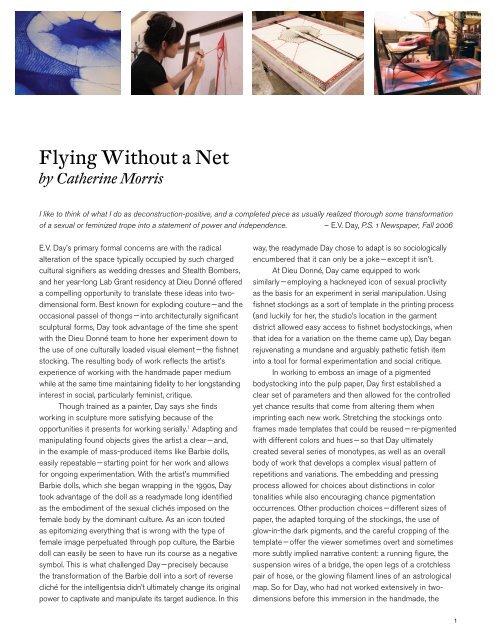Dieu Donné Lab Grant Program, Publication Series no. 13 - E.V. Day
Dieu Donné Lab Grant Program, Publication Series no. 13 - E.V. Day
Dieu Donné Lab Grant Program, Publication Series no. 13 - E.V. Day
You also want an ePaper? Increase the reach of your titles
YUMPU automatically turns print PDFs into web optimized ePapers that Google loves.
Flying Without a Net<br />
by Catherine Morris<br />
I like to think of what I do as deconstruction-positive, and a completed piece as usually realized thorough some transformation<br />
of a sexual or feminized trope into a statement of power and independence. – E.V. <strong>Day</strong>, P.S. 1 Newspaper, Fall 2006<br />
E.V. <strong>Day</strong>’s primary formal concerns are with the radical<br />
alteration of the space typically occupied by such charged<br />
cultural signifiers as wedding dresses and Stealth Bombers,<br />
and her year-long <strong>Lab</strong> <strong>Grant</strong> residency at <strong>Dieu</strong> <strong>Donné</strong> offered<br />
a compelling opportunity to translate these ideas into twodimensional<br />
form. Best k<strong>no</strong>wn for exploding couture — and the<br />
occasional passel of thongs — into architecturally significant<br />
sculptural forms, <strong>Day</strong> took advantage of the time she spent<br />
with the <strong>Dieu</strong> <strong>Donné</strong> team to hone her experiment down to<br />
the use of one culturally loaded visual element — the fishnet<br />
stocking. The resulting body of work reflects the artist’s<br />
experience of working with the handmade paper medium<br />
while at the same time maintaining fidelity to her longstanding<br />
interest in social, particularly feminist, critique.<br />
Though trained as a painter, <strong>Day</strong> says she finds<br />
working in sculpture more satisfying because of the<br />
opportunities it presents for working serially. 1 Adapting and<br />
manipulating found objects gives the artist a clear — and,<br />
in the example of mass-produced items like Barbie dolls,<br />
easily repeatable — starting point for her work and allows<br />
for ongoing experimentation. With the artist’s mummified<br />
Barbie dolls, which she began wrapping in the 1990s, <strong>Day</strong><br />
took advantage of the doll as a readymade long identified<br />
as the embodiment of the sexual clichés imposed on the<br />
female body by the dominant culture. As an icon touted<br />
as epitomizing everything that is wrong with the type of<br />
female image perpetuated through pop culture, the Barbie<br />
doll can easily be seen to have run its course as a negative<br />
symbol. This is what challenged <strong>Day</strong> — precisely because<br />
the transformation of the Barbie doll into a sort of reverse<br />
cliché for the intelligentsia didn’t ultimately change its original<br />
power to captivate and manipulate its target audience. In this<br />
way, the readymade <strong>Day</strong> chose to adapt is so sociologically<br />
encumbered that it can only be a joke — except it isn’t.<br />
At <strong>Dieu</strong> <strong>Donné</strong>, <strong>Day</strong> came equipped to work<br />
similarly — employing a hackneyed icon of sexual proclivity<br />
as the basis for an experiment in serial manipulation. Using<br />
fishnet stockings as a sort of template in the printing process<br />
(and luckily for her, the studio’s location in the garment<br />
district allowed easy access to fishnet bodystockings, when<br />
that idea for a variation on the theme came up), <strong>Day</strong> began<br />
rejuvenating a mundane and arguably pathetic fetish item<br />
into a tool for formal experimentation and social critique.<br />
In working to emboss an image of a pigmented<br />
bodystocking into the pulp paper, <strong>Day</strong> first established a<br />
clear set of parameters and then allowed for the controlled<br />
yet chance results that come from altering them when<br />
imprinting each new work. Stretching the stockings onto<br />
frames made templates that could be reused — re-pigmented<br />
with different colors and hues — so that <strong>Day</strong> ultimately<br />
created several series of mo<strong>no</strong>types, as well as an overall<br />
body of work that develops a complex visual pattern of<br />
repetitions and variations. The embedding and pressing<br />
process allowed for choices about distinctions in color<br />
tonalities while also encouraging chance pigmentation<br />
occurrences. Other production choices — different sizes of<br />
paper, the adapted torquing of the stockings, the use of<br />
glow-in-the dark pigments, and the careful cropping of the<br />
template — offer the viewer sometimes overt and sometimes<br />
more subtly implied narrative content: a running figure, the<br />
suspension wires of a bridge, the open legs of a crotchless<br />
pair of hose, or the glowing filament lines of an astrological<br />
map. So for <strong>Day</strong>, who had <strong>no</strong>t worked extensively in twodimensions<br />
before this immersion in the handmade, the<br />
1


